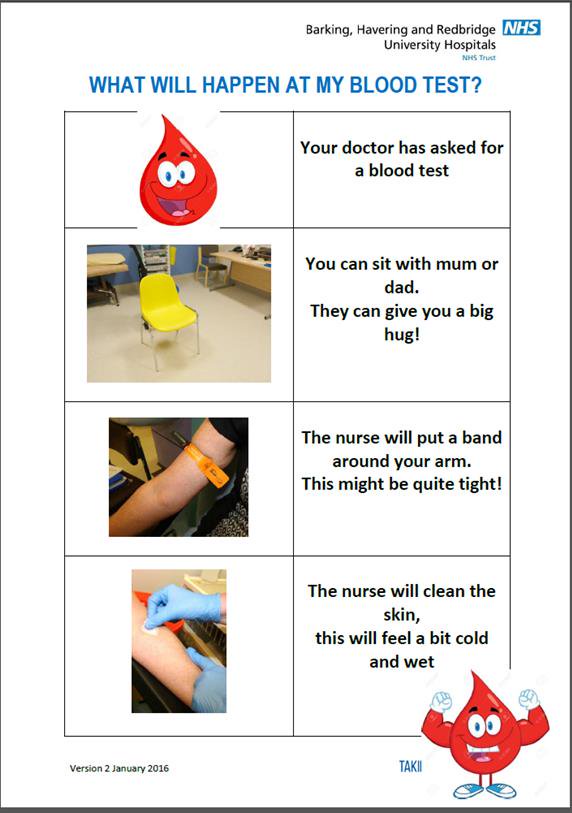 Easy read helps explain a procedure using simple language and pictures.
Easy read helps explain a procedure using simple language and pictures.The Children's Phlebotomy service at Queen's Hospital in Romford is the only local service providing blood tests to children with Special Needs.
The Phlebotomists have helped 403 children and young people with special needs receive their blood tests in the year April 2016 to March 2017. This is due to their patience, empathy and caring attitude to make reasonable adjustments for these patients.
The Easy read Blood Test information has been used on numerous occasions. Not only does this aim to relieve the anxieties of the young person, but also the anxiety of the parent, who now has a better understanding of what to expect and how to explain the procedure in a way the young person can understand.
 This aims to alleviate the fear of the unknown, young people feel prepared coming in for blood tests. They are not discriminated against, as the young person is communicated with in a way that is suitable to meet their communication technique. This not only helps children and young people with Learning Disabilities or Autism, but will also aim to help those who have high anxiety or those whose first language is not English, or any other communication difficulty.
This aims to alleviate the fear of the unknown, young people feel prepared coming in for blood tests. They are not discriminated against, as the young person is communicated with in a way that is suitable to meet their communication technique. This not only helps children and young people with Learning Disabilities or Autism, but will also aim to help those who have high anxiety or those whose first language is not English, or any other communication difficulty.The pictures show the journey in a step by step process, from the chair that the children and young people sit, the process of blood testing, through to a plaster, high-five and a sticker. The senior sister for the Children's Outpatient department has commented that the young people coming to their appointments seem calmer.
One young person I have worked closely with used to require 3 or 4 members of staff to hold him down to have his blood test. He now uses this pictorial communication guide to better his understanding of what happens next. His mother has tailored the communication tool to include just 4 steps that he can easily process.
His own words are: 'Cold Spray, Tiny Scratch, Needle, All done.' At his last blood test, he sat on his mother's lap and distracted himself with an electronic device.
Following the success of his story, this communication tool has been promoted within other hospital settings, including Great Ormond Street, as well as permission being sought to use this within a local GP practice. The mother is now using this same method of communication in other areas of his medical care, including dental, ultrasound and doctor examinations. She has fed-back that this has changed not only her son's life, but also that of her family.

